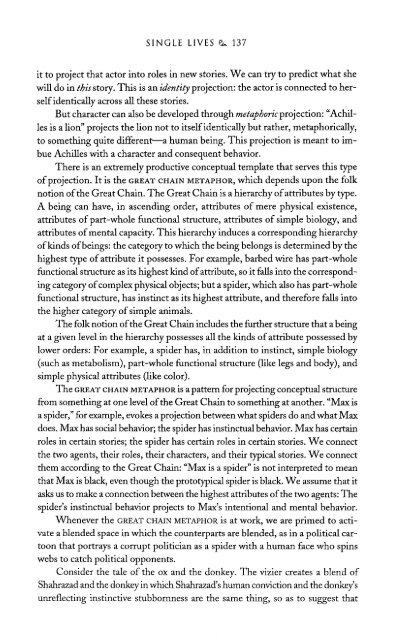The Literary Mind.pdf
The Literary Mind.pdf
The Literary Mind.pdf
You also want an ePaper? Increase the reach of your titles
YUMPU automatically turns print PDFs into web optimized ePapers that Google loves.
SINGLE LIVES 137<br />
it to project that actor into roles in new stories. We can try to predict what she<br />
will do in this story. This is an identity projection: the actor is connected to herself<br />
identically across all these stories.<br />
But character can also be developed through metaphoric projection: "Achilles<br />
is a lion" projects the lion not to itself identically but rather, metaphorically,<br />
to something quite different—a human being. This projection is meant to imbue<br />
Achilles with a character and consequent behavior.<br />
<strong>The</strong>re is an extremely productive conceptual template that serves this type<br />
of projection. It is the GREAT CHAIN METAPHOR, which depends upon the folk<br />
notion of the Great Chain. <strong>The</strong> Great Chain is a hierarchy of attributes by type.<br />
A being can have, in ascending order, attributes of mere physical existence,<br />
attributes of part-whole functional structure, attributes of simple biology, and<br />
attributes of mental capacity. This hierarchy induces a corresponding hierarchy<br />
of kinds of beings: the category to which the being belongs is determined by the<br />
highest type of attribute it possesses. For example, barbed wire has part-whole<br />
functional structure as its highest kind of attribute, so it falls into the corresponding<br />
category of complex physical objects; but a spider, which also has part-whole<br />
functional structure, has instinct as its highest attribute, and therefore falls into<br />
the higher category of simple animals.<br />
<strong>The</strong> folk notion of the Great Chain includes the further structure that a being<br />
at a given level in the hierarchy possesses all the kinds of attribute possessed by<br />
lower orders: For example, a spider has, in addition to instinct, simple biology<br />
(such as metabolism), part-whole functional structure (like legs and body), and<br />
simple physical attributes (like color).<br />
<strong>The</strong> GREAT CHAIN METAPHOR is a pattern for projecting conceptual structure<br />
from something at one level of the Great Chain to something at another. "Max is<br />
a spider," for example, evokes a projection between what spiders do and what Max<br />
does. Max has social behavior; the spider has instinctual behavior. Max has certain<br />
roles in certain stories; the spider has certain roles in certain stories. We connect<br />
the two agents, their roles, their characters, and their typical stories. We connect<br />
them according to the Great Chain: "Max is a spider" is not interpreted to mean<br />
that Max is black, even though the prototypical spider is black. We assume that it<br />
asks us to make a connection between the highest attributes of the two agents: <strong>The</strong><br />
spider's instinctual behavior projects to Max's intentional and mental behavior.<br />
Whenever the GREAT CHAIN METAPHOR is at work, we are primed to activate<br />
a blended space in which the counterparts are blended, as in a political cartoon<br />
that portrays a corrupt politician as a spider with a human face 'who spins<br />
webs to catch political opponents.<br />
Consider the tale of the ox and the donkey. <strong>The</strong> vizier creates a blend of<br />
Shahrazad and the donkey in which Shahrazad's human conviction and the donkey's<br />
unreflecting instinctive stubbornness are the same thing, so as to suggest that















